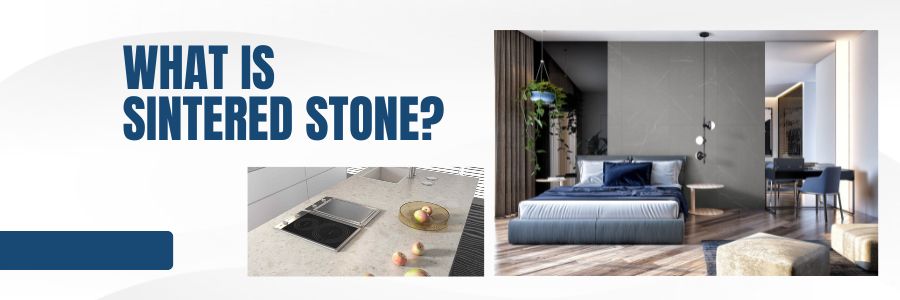In the ever-evolving world of building materials, there’s a rising star that’s catching the eye of architects, designers, and homeowners everywhere: sintered stone. This cool material is not only changing the game in construction and design but also setting new benchmarks for durability and versatility.
For importers, getting the scoop on sintered stone opens doors to new business and meets the demand for top-notch, eco-friendly building stuff.
What Is Sintered Stone?
Sintered stone is a manufactured material that mimics the appearance of natural stone but offers enhanced properties thanks to its unique production process. It is created through a technology that applies intense heat and pressure to raw materials, this results in a highly durable, compact surface that stands up well against scratching, staining, heat, and UV light.
Actually, the sintered stone, porcelain tile, and stone look similar in some ways, but sintered stone features a higher compressive strength, nearly zero porosity, and improved flexibility. This unique combination of properties makes it an ideal choice for applications such as countertops, flooring, cladding, and even furniture. In a word, you can simply understand that sintered stone is an upgraded version of ceramic tiles and natural stone.
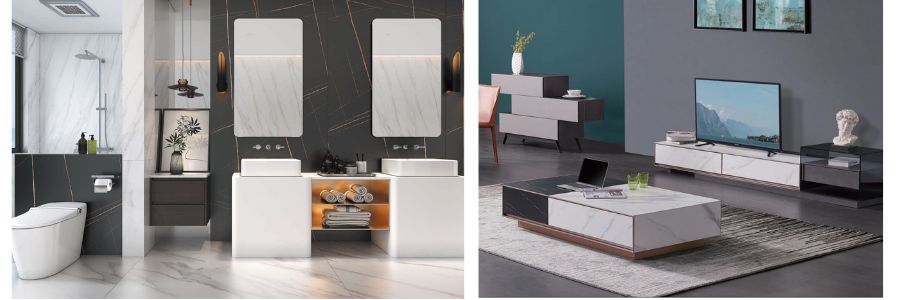
Sintered Stone Pros and Cons
Before diving into the importation of sintered stone, it’s crucial to weigh its advantages and disadvantages.
Pros Of Sintered Stone:
- Durability: Sintered stone is renowned for its resistance to scratches, stains, and heat, fireproof, acid and alkali resistant, and it can cook food directly on the stone. It’s an environmentally friendly and healthy food grade.
- Versatility: Slimmer and lighter than stone, and available in a wide range of finishes and colors, it can mimic the appearance of marble, concrete, jade, metal, wood, and, further, linen finishes, offering endless design possibilities for you.
- Low Maintenance: While replicating the marble or stone style, sintered stone solved the shortcoming of the stone, it doesn’t require sealing and is easy to clean, making it a practical choice for busy environments.
- Lower Price: It’s a common belief that sintered stone is quite costly, and to some extent, this is true, especially when compared to ceramic tiles. However, when juxtaposed with natural stone, sintered stone is notably more affordable.
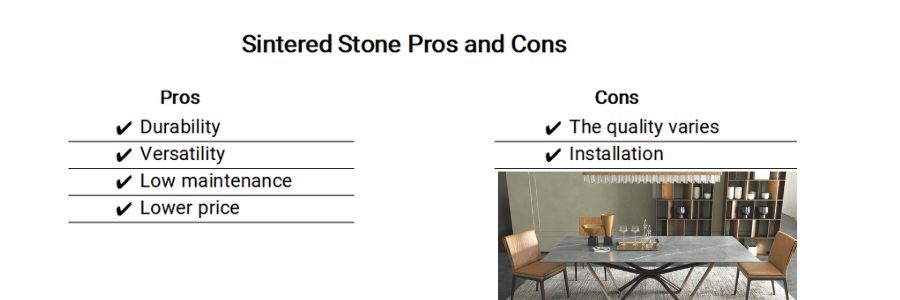
Cons Of Sintered Stone:
- The quality varies: Due to the absence of a national standard in China, the classification of sintered stone remains ambiguous. Although many products are labeled as sintered stone, there can be significant variations in quality.
- Installation: The substantial size of sintered stone requires advanced logistical and processing capabilities. The need for specialized equipment and expert knowledge for cutting and installation could elevate the overall project expenses.
What Is Sintered Stone Used For?
Sintered stone’s exceptional properties make it suitable for a vast array of applications, from residential to commercial projects.
Currently, the market offers a wide range of sizes for your selection, including the following dimensions: 60x120cm, 75x150cm, 80x140cm, 80x200cm, 80x240cm, 80x260cm, 90x180cm, 120x240cm, 120x270cm, and 160x320cm. Available thicknesses are 3mm, 4.8mm, 6mm, 9mm, 12mm, and 15mm.
Based on the specific application area and different thicknesses, we can customize the size to meet your needs. For residential projects, these materials can be applied in a variety of applications, as below:
Sintered Stone Countertops
One of the most popular uses is on countertops. Its resistance to heat, stains, and scratches, coupled with its beautiful appeal, makes sintered stone an excellent choice for kitchens and bathrooms. The thickness is usually 12 or 15mm. Moreover, its hygienic surface, which is resistant to bacteria and mold growth, ensures a safe environment for food preparation and personal care.
However, it’s worth noting that this type of sintered stone vanity (the countertop and basin bowl are made of sintered stone) has a cleaning issue. The corners are rectangular, making them difficult to clean.
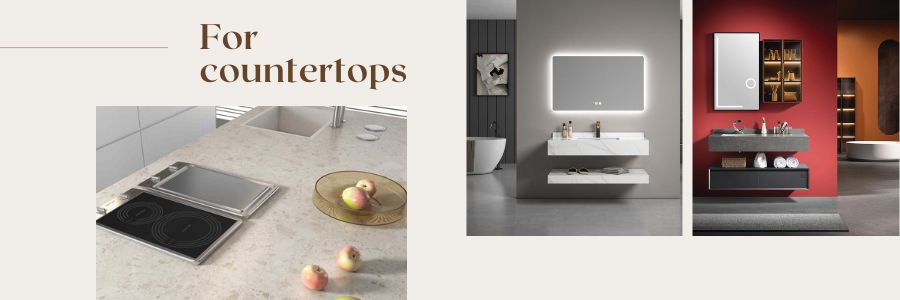
For Furniture
Sintered stone is gaining popularity for furniture and cabinet door panels, prized for its durability and aesthetic versatility. Capable of emulating natural wood, stone, or complex patterns, it fits well with various design themes, from minimalist to contemporary. Its exceptional durability stands out, especially in high-use areas. Sintered stone’s resistance to scratches, dents, and stains ensures it keeps its new look over time, making it perfect for kitchens and bathrooms.
Besides its strength, sintered stone is highly resistant to water and moisture, preventing the deformation common with natural wood in humid conditions. Its non-porous nature also makes it hygienic, not allowing bacteria or mold to settle, and it is easy to clean, requiring just a simple wipe. This makes sintered stone an ideal material for maintaining, function, and cleanliness in any home.
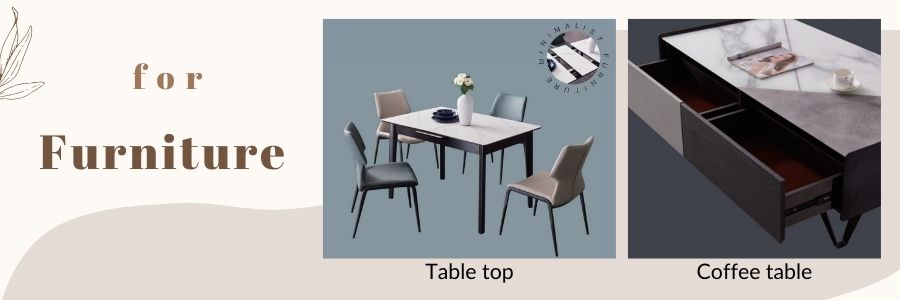
For Wall And Flooring
Sintered stone stands as an exemplary choice for wall and flooring, offering architects and designers a durable and versatile option that beautifully complements any space. Its robust nature ensures it can withstand high traffic areas, making it suitable for both residential and commercial properties.
The aesthetic flexibility of sintered stone means it can be manufactured to resemble natural stone, concrete, or even intricate textures, allowing for a seamless integration into various design schemes. Its large format tiles can create expansive, seamless surfaces, make the space more coherent and look more atmospheric and beautiful.
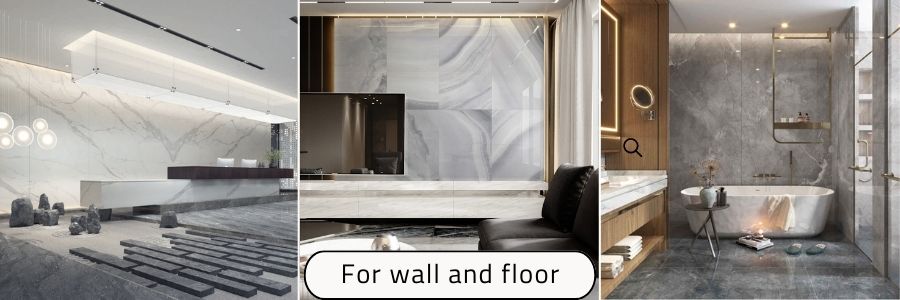
Materials Comparative Analyses
When picking out countertop materials to import, it’s really important to see how sintered stone compares to favorites like quartz and porcelain.
Sintered Stone Vs. Quartz
When deciding between sintered stone and quartz for countertops, it’s really about weighing the perks of their durability and looks. Both of these two materials are durable, good-looking, and suitable for kitchen and bathroom countertops.
Sintered stone is amazing for both indoor and outdoor applications because it stands up so well to UV rays, heat, and all sorts of weather challenges. This makes it perfect for outdoor kitchens or any spot that gets a lot of sun.
Quartz has its charm with a wide variety of colors and patterns that look just like natural stone. However, it’s not the best choice for outdoor spaces or anywhere in high-heat conditions. The resins in quartz countertops are susceptible to damage from UV light and can get discolored or warped over time. Additionally, quartz is not heat-resistant; forget about putting a hot pan directly on it; that can cause damage to the quartz surface, that’s a no-go.
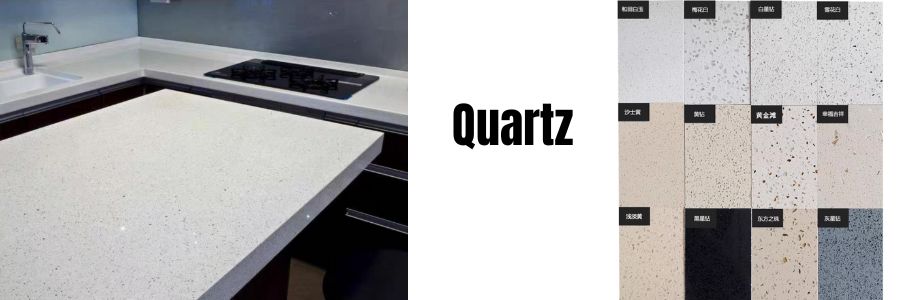
So, while both options look great, if you need something tough that can handle the extreme heat, sintered stone is the way to go.
Sintered Stone Vs. Porcelain Tile
At first glance, these two materials seem similar. They’re both man-made materials that excel in durability, and they are popular for floors and surfaces like countertops.
However, upon closer examination, you’ll find that sintered stone pulls ahead in a couple of key areas: hardness and food safety – aspects where porcelain tiles just can’t quite keep up.
Superior Hardness
One of the most significant advantages of sintered stone is its exceptional hardness. In contrast, porcelain tiles, while still durable, do not reach the same level of hardness. They can be susceptible to chipping or cracking under high pressure. So the porcelain is not perfect for the countertops.
Food Safety
When it comes to kitchen countertops, one of the most critical considerations is food safety. Here, sintered stone truly shines, offering an unparalleled hygienic surface that’s perfect for food preparation. Its non-porous nature means there are no tiny crevices for bacteria or mold to hide and multiply, a common issue with many other materials.
Moreover, sintered stone does not interact with food items or release harmful chemicals, making it a safe platform for all your culinary adventures. Porcelain tiles, while easy to clean and resistant to bacteria, cannot claim the same food-grade safety level. The glazes used on porcelain tiles may contain lead or cadmium, especially in older or hand-painted tiles, which could pose a risk if they come into contact with food.

Sintered stones have a lot going for them, like being super durable and safe for food contact, but prices are higher. When you’re doing up wall and floors, where you might not need the extreme toughness or food safety features of sintered stone, porcelain tiles are a smart, wallet-friendly choice. They’re tough enough for most projects and offer a good mix of quality and value, making them perfect for all sorts of spaces.
Sintered Stone Vs. Marble
Marble has always been cherished for its natural beauty and elegance, making it a popular choice for home decor. But we have to face its tendency to stain and scratch, which can be a pain for homeowners.
That’s why people have been on the lookout for something that looks just as good but doesn’t demand high maintenance. Sintered stone has arrived on the scene as the perfect solution. This game-changer offers the gorgeous aesthetic of marble, minus the fragility.
In Conclusion
The comparison between sintered stone and other popular materials such as quartz, porcelain, and marble illuminates the unique advantages sintered stone brings to the table. Its unparalleled durability, resistance to extreme conditions, and superior food safety standards make it an outstanding choice for both indoor and outdoor applications, including countertops, floors, and walls.
Despite its higher price point, the long-term benefits and aesthetic versatility of sintered stone justify the investment. For homeowners and designers seeking a material that combines beauty with exceptional performance, sintered stone is a compelling option that promises to elevate any space without the maintenance and durability concerns associated with other materials.

